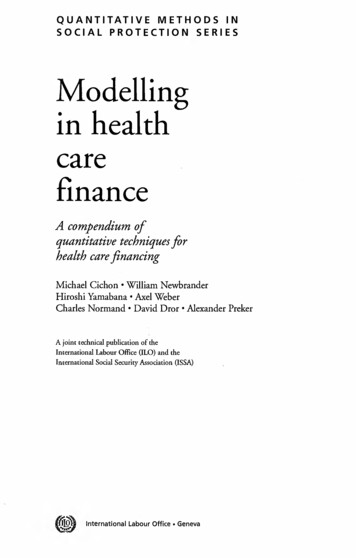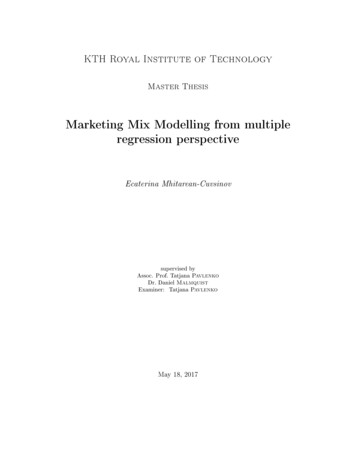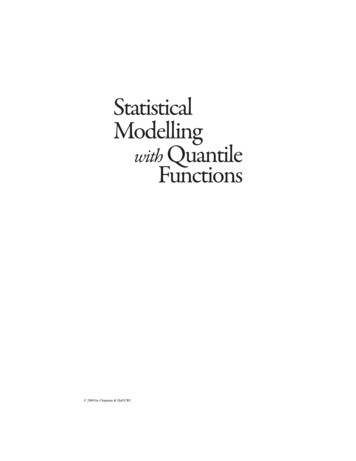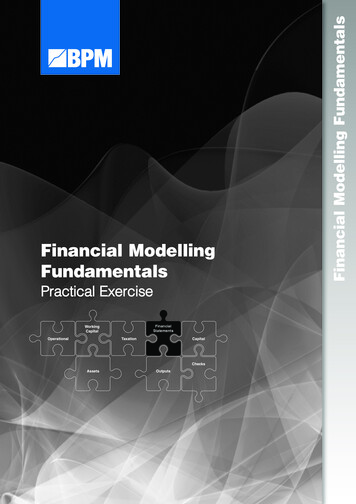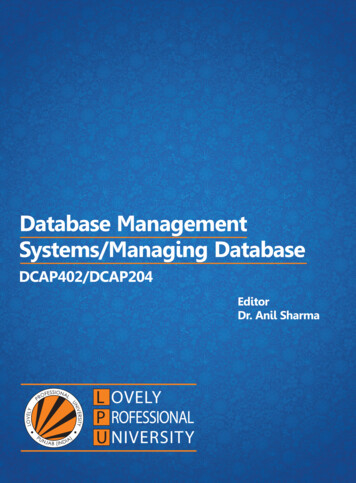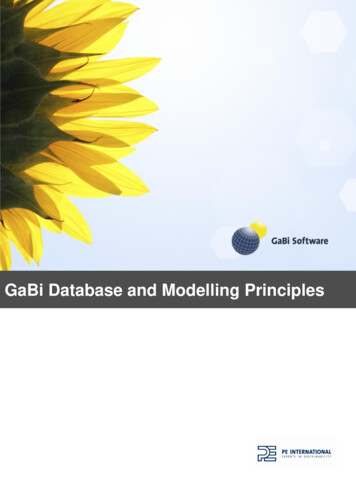
Transcription
GaBi Database and Modelling Principles
GaBi Database and Modelling Principles, Version 5.0, November 2011Authors:Martin Baitz, Cecilia Makishi-Colodel, Thilo Kupfer,Julia Pflieger, Oliver Schuller, Fabian Hassel, MortonKokborg, Lauren Fongwith contributions of the expert teams:Energy, Transport, Metals, Chemicals and Polymers,Construction, Renewables, Electronic, End-of-Life,WaterPE INTERNATIONAL AGHauptstraße 111 – 11370771 Leinfelden – EchterdingenGermanyPhoneFax 49 711 341817 – 0 49 711 341817 – ternational.com
List of ContentsList of ContentsList of Contents . 3List of Figures . 5List of Tables . 6Abbreviations . 71Introduction and aim of document . 82GaBi LCA database framework . 92.1GaBi Database concept and management . 92.2GaBi Database development, maintenance and update . 112.3Structure of the Master Database contents . 132.4Standardisation, compliance and application issues of LCI databases . 202.5Databases in reference networks, standards and principles . 212.6GaBi LCI Team . 223Methodological framework . 243.1Definition of tasks in database work . 243.2Goal . 243.3Scope . .103.3.113.3.12Function and Functional Unit . 26Definition of terms within system boundaries . 26System boundaries for the creation of standard LCI cradle to gatedatasets . 27Cut-offs . 34Gap closing . 36Infrastructure . 36Transportation . 38Water . 39Wastes and recovered material or energy . 46Aspects of biomass modelling . 47Aspects of primary energy of fossil and renewable energy sources . 48Land Use Change . 493.4Sources and types of data . 523.4.13.4.23.4.33.4.43.4.5Primary and secondary sources of data . 52Unit process and aggregated data . 53Units . 54LCI data and supported LCIA methods . 54Production and consumption mix . 553.5Data quality issues. 573.5.13.5.23.5.33.5.43.5.5Technology and region coverage . 57Data aggregation . 58Precision, completeness, representativeness . 60Consistency . 61Uncertainty . 623
List of Contents4System Modelling Features . 684.1Data collection . 684.1.14.1.24.1.3Quality check and validation of collected data. 69Treatment of missing data . 69Transfer of data and nomenclature . 694.2Geographical aspects of modelling . 714.3Parameter. 724.4Multifunctionality and allocation principle . 724.5Generic Modules as background building block . al modelling features for specific areas . 74Energy . 75Transport . 80Mining, metals and metallurgy . 85Chemistry and plastics. 87Construction . 92Renewables . 94Electronics . 98Recycling or End-of-Life measures . 1015Review, documentation and validation . 1095.1Review procedures and check routines . 1095.1.15.1.25.1.3Technical information and documentation routines in GaBi. 109Important material and energy balances . 110Plausibility of emission profiles and avoiding errors . 1105.25.2.15.2.25.2.3Documentation . 111Nomenclature . 112Documentation of Flows . 112Documentation of LCI process data . 1125.3Validation . 1146Literature . 115Supplement ADescription of result and impact categories . 120Supplement A 1Primary energy consumption. 120Supplement A 2Waste categories . 120Supplement A 3Global Warming Potential (GWP) . 121Supplement A 4Acidification Potential (AP), CML. 124Supplement A 5Eutrophication Potential (EP), CML . 126Supplement A 6Photochemical Ozone Creation Potential (POCP) . 129Supplement A 7Ozone Depletion Potential (ODP). 131Supplement A 8Human and eco-toxicity, USEtox . 134Supplement A 9Abiotic Depletion Potential, CML . 138Supplement BBackground information on uncertainty . 1404
List of FiguresList of FiguresFigure 3-2Generic example product system of a dataset development .27Figure 3-3Application water flows in open-loop and closed-loop coolingsystems in various industrial settings .42Figure 3-4Application water flows in once-through cooling and cooling towersin energy/electricity generation .44Figure 3-5Application water flows in hydropower generation .45Figure 3-6Ad hoc example of a simple plan system including differentprocesses and water flows .45Figure 3-7:Difference between "production mix" and "consumption mix"(forpower generation) .56Figure 4-1:Hierarchical structure of the processes and plans.71Figure 4-2:Conventional natural gas production in Germany .76Figure 4-3:Natural gas supply for Germany .77Figure 4-4:US, East electricity grid mix .78Figure 4-5:Parameterized US Coal gas CHP power plant .79Figure 4-6:Excerpt of the organic network considered in GaBi.88Figure 4-7:Consumption mix of Epoxy resin in Germany .90Figure 4-8:Example of PVC resin - compound- part .92Figure 4-9:Schematic life cycle of a building .93Figure 4-10:Nitrogen in the agrarian system .96Figure 4-11:Creation of a model for an electronic product - modular structurevia Generic Modules .100Figure 4-13:Exemplary incineration model with in GaBi (here averageEuropean domestic waste treatment with dry offgas cleaning).104Figure 4-14:Details of incineration and dry offgas cleaning in GaBi incinerationmodel .104Figure 4-15:Examplary landfill model in GaBi (here commercial wastecomposition for certain geographic example regions) .106Figure 4-16:Exemplary wastewater treatment model in GaBi (here municipalwastewater for German circumstances) .107Figure 5-1:Example documentation in GaBi (excerpt) [GABI 2011] .1135
List of TablesList of TablesTable 3-1Background system boundaries.28Table 3-2Relevancy of infrastructure of a natural gas power plant in GaBiMaster DB (selected representative sample power plant) .37Table 3-3Publicly available example value for a medium size gas powerplant .37Table 3-4Publicly available example values for CO2 for a gas power plant .38Table 3-5General treatment procedure (if no specific information isavailable) for common materials/wastes .47Table 3-6General procedure for some hazardous waste flows .47Table 3-7:Overview of the Land Use Change Indicator Units.50Table 3-8:Overview of qualitative importance of “quality indicators” in GaBiDBs .57Table 3-10Coefficients of variation .666
AbbreviationsAbbreviationsAPAcidification PotentialADPAbiotic Depletion tomerCHPCombined Heat and Power PlantDeNOxNOx emission reductionDeSOxSOx emission reductionDBDatabaseELCDEuropean Reference Life Cycle Data SystemEoLEnd-of-LifeEPEutrophication PotentialFAETPFreshwater Aquatic Ecotoxicity PotentialGWPGlobal Warming PotentialHTPHuman Toxicity PotentialIEAInternational Energy AgencyIPCCInternational Panel on Climate ChangeILCDInternational Lifecycle Reference SystemKEACumulated Energy Approach (Kumulierter Energieaufwand)LCALife Cycle AssessmentLCILife Cycle InventoryLCIALife Cycle Impact AssessmentMAETPMarine Aquatic Ecotoxicity PotentialMSWMunicipal Solid WasteNDANon Disclosure AgreementODPOzone Depletion PotentialPOCPPhotochemical Ozone Creation PotentialSCRSelective catalytic reduction (DeNOx type)SNCRSelective non catalytic reduction (DeNOx type)TETPTerrestric Ecotoxicity PotentialWtEWaste-to-Energy7
Introduction and aim of document1 Introduction and aim of documentConsistency, Relevancy, Quality, Continuity are the main drivers in the GaBi database.The GaBi databases contain over 300 person-years of direct data collection and compilation. PE staff with an experience of over 1000 person-years contributes constantly to themanagement and development of the GaBi databases.The goal of “GaBi Database and Modelling Principles” is to transparently document theenvironment, background, important aspects and details of the GaBi databases, as wellas the basis of the models.Furthermore, the database management is described – an important aspect of professional databases in practise – as well as update and maintenance procedures and strategies.Finally, important, general, methodological aspects and branch- or expert-specific methodological aspects are documented.This document is the basis of all GaBi databases, the professional database and the extension databases, as well as all data-on-demand datasets.8
GaBi LCA database framework2 GaBi LCA database frameworkSuccessful, continuous and effective database provision needs-a professional database concept and management,-consistent and central database development and-database maintenance as well as frequent and efficient update routines.To enable a flexible use of the database content in different Life-Cycle- related applications, Life-Cycle Management tasks and professional decision situations, the data shouldbe suitable and adaptable to different schemes and standards of industrial and professional practise and should most importantly reflect the real supply chain and technologysituation. Well-educated and broadly experienced teams of different branches and expertgroups with broad experience in their areas of expertise are important.The methods and methodological choices used have been selected to reflect the supplynetworks in the most appropriate way. “Method follows reality.”2.1GaBi Database concept and managementThe database concept is embedded into the solution concept of PE INTERNATIONAL.This Master DB concept is one core pillar of our three pillar solution approach, which isaccompanied by engineering consulting knowledge and a professional software environment.Figure 2-1:GaBi Database concept embedded in 3 pillar solution approachDatabase development at PE involves experts on LCA methodology, with technical expertise (see Chapter 2.6 for details on the different teams), as well as knowledge of the supply chain. Relevance checks and routine quality assurance checks are applied. The generation of new data follows a standard procedure with “cascade quality checks” and isembedded into the GaBi Master DB concept.Internal entry quality checks: Newly generated data first passes a purely internal qualitycheck, by two LCA experts with engineering skills at PE International, in a dependent internal review, before entering the database environment.Internal resulting quality checks: Depending on the type of data and its intended use,field of expertise and the sources providing the data (internal or external sources and/ororganisations), a second check or validation by our cooperative partners LBP University ofStuttgart and Fraunhofer IBP or other independent organisations are undertaken, as anindependent internal review.9
GaBi LCA database frameworkExternal resulting non-public quality checks: Data, which is generated together withindustry or associations for distribution with GaBi databases into the professional LCAuser community (e.g. Eco-profile-type data or other representative averaged industry dataof different companies or an individual dataset of single companies), undergo an additional quality check by the respective data providers or selected neutral third party organisations, as an independent external review or third party review.External resulting public quality checks: The dataset and systems, which are providedwith our software and databases for public use to a broad user community, are constantlyused, compared, benchmarked, screened and reviewed, and the results are published invarious external, professional and third party LCA applications in industry, academia andpolitics. User feedback via the online GaBi forum or direct via user information is standardin the maintenance and update process of the databases and leads to consistent quality,constant control and improvement of data, if knowledge or technology improves, or industrial process chains develop and change, as independent public or “cloud” reviews.The Database Management at PE INTERNATIONAL protects private and project-relatedinformation of customers and clients, while enabling customers and clients to best benefitfrom the general, usable part of the internal information and knowledge and expertise poolof PE.Any information that leaves the PE internal database area needs release permission andis centrally distributed.Figure 2-2:Database Management at PE INTERNATIONALAny confidential project or customer-related information is protected by a “Non-DisclosureAgreement (NDA)” and securely separated from any publicly available database.10
GaBi LCA database framework2.2GaBi Database development, maintenance and updateAfter observation of the LCA developments over the last 20 years it becomes obvious thatthe motivation to start using LCA approaches two decades ago is industry-driven. Naturally all data should ideally be “industry borne,” meaning the data are validated or sourcedfrom or within industry to ensure the proper representation of real circumstances. So “data” is a typical topic for LCA work with and in industry.The need for sound methodological approaches within database and LCI modelling hasattracted the academic world and later, standardisation bodies.LCA databases began appearing in the early 1990s - some with software systems. GaBiwas the only pioneer having both database and software system at hand from the beginning, opening up synergies and unique possibilities.LCA Databases are growing in relevance. GaBi databases evolved and established LCAin daily use early within research and industry. Only professionally managed, maintainedand updated databases continue to be relevant in practise.Maintaining and updating databases is an important, although time- and managementintensive task. Accuracy of data, new (practical, proven) methods and user needs are justthree examples that need constant attention. And constant attention requires a consistentgroup of people taking care of specific topics and branches. New scientific findings, new data and technologies and new methods need constant database development. Decisions for development of new products based on LCA and optimisation or investment depend on reliable results, applicability and continuity in daily practise.GaBi database development combines the important aspects of these requirements. TheGaBi database employs proven “best practice” data and approaches. New scientificmethods and data are applied only after feasibility checks to reduce risks of wrong (product or process) decisions. “Best practice” is based on the “latest science.”The GaBi database work is considered to be done “for practice with information from practise” and therefore considers the “critical success factors” in professional LCA applications. GaBi data is therefore not just any randomly available data, but rather best practisedata.We have access to raw data sources developed by PE and in-house engineering expertise, which enables PE to develop and deliver within scope, on time, with high quality andprovide guidance towards suitable data and data selection. A standard format for all LCIdatasets is mandatory for all PE-owned data.PE considers its data to be “Industry-borne” as we aim for stakeholder involvement andvalidation on data developments with suitable contacts, sources and published industrydata. PE always welcomes feedback, constructive criticism and suggestions for improvement.We model real supply chains for inter-sectoral use for all B2B and B2C relationships. Thedata reflect specific and up-to-date technology and technology routes for individualbranches. Region-specific background systems are combined, wherever suitable andpossible, with local/regional process technology information. Individual, user-specific mod11
GaBi LCA database frameworkification, adaptation and extension on local situations with customer-owned data or parameterised data are possible. Individual data on demand can be constructed according tothe same routine for best consistency.The ultimate goal is to attain flexibility in the application of our data to address differenttopics and allowing flexible assimilation between political and industrial decision contexts.In other words the same database can be used in making a quick decision or in an intensive investment decision.Regarding development, maintenance and update environment, a suitable group structure(see Chapter 2.6 for details) with different responsibilities at PE is in place. There is a direct relationship between software and database development, which supports practicaland relevant solution pathways, seeing as many issues deal with both fields.Maintenance and support routines are installed and updates are regularly conducted withthe least possible user effort required including smart database/software updates withautomated addition of new standard LCI or LCIA data.Figure 2-3:Update road map of GaBi databases: Yearly update cycles.12
GaBi LCA database framework2.3Structure of the Master Database contentsThe Master Database is the core data knowledge memory and contains about 10,000generic plan systems, each with one or more unit processes and several sub-systems.In some cases single cradle-to-gate systems involve several thousand individual plan systems and tens of thousands of individual processes tracing back to the resources.Figure 2-4:Hierarchical system in GaBiEach PE-owned, aggregated process provided in the public available databases has acorresponding plan system, unit processes and sub-systems with sub unit-processes inthe Master Database.Huge systems result, which are hardly manageable without suitable LCA software support. In principle it would be possible to display all sub-systems of all processes and plansof the complete Master DB. The resulting document would probably have about a quarterof a million pages1. This is one main reason why GaBi and its corresponding Master database were developed: To be able to transparently and simply manage and use large process chain systems of real supply chains.The graphical display for this document is therefore limited to an example. It aims totransparently document the structural background of the Master Database. Further publicly available process chain and technology information on all datasets and systems is covered in the documentation.We offer to share more details and process chain knowledge through bilateral businessrelationships.The publicly-available databases contain plan systems, unit processes, partially aggregated processes and aggregated processes.1rough estimate assuming two screenshots per page.13
GaBi LCA database frameworkFigure 2-5:Aggregated dataset in GaBi.Aggregated processes are often the only way to provide relevant, suitable and up-to-dateinformation of industrial sources to the LCA user community. Many users consider aggregated processes the best way to reliably and representatively model existing backgroundsystems.PE has added value from unit process data collection and compilation, including verification of technical realistic boundaries, to country-specific supply chain modelling.Opening the first level of the related polytetraflourethylene production in the Master database shows the polymerization step with the respective unit process in the centre. Upstream sub-systems are shown on the right (in the unit process only technical flows arevisualised; elementary flows such as resources or emissions are not visualised, but definitely physically and mathematically present in the individual unit processes).14
GaBi LCA database frameworkFigure 2-6:Polymerisation subsystem in GaBi Master DB.We follow one single upstream pathway from Tetraflourethylene (indicated by the red circle; details are shown in the next figure) 15
GaBi LCA database framework.Figure 2-7:Tetraflourethylene subsystem in GaBi Master DB. to R22 details and chlorine mix details (marked in red) Figure 2-8:R22 subsystem in GaBi Master DB.16
GaBi LCA database frameworkFigure 2-9:Chlorine production mix in GaBi Master DB. then to chlorine membrane technology details (marked in red) and back to rock saltmining.Figure 2-10:Chlorine membrane technology production in GaBi Master DB.The previous example showed the journey from polymer back to rock salt. The followingexample gives insight to the fossil fuel and organic process chain. Starting with the various refinery products diesel, gasoline, naphtha and gases on the right side .17
GaBi LCA database frameworkFigure 2-11:Refinery model in GaBi Master DB. the refinery products progress through the different refinery stages to the crude oil inputon the left .Figure 2-12:Crude oil import mix and country specific oil extraction in GaBi Master DB. and from the right side of crude oil import mix to country-specific oil extraction and thebore hole at the source.The last example shows the electricity modelling in GaBi Master Database.18
GaBi LCA database frameworkFigure 2-13:Power plant models of the Grid Mix modelling in GaBi Master DB.The output which results on the right side of above screenshot is 1 kWh of electricity. Onthe right next to the hydro, wind, waste and nuclear power plants, the necessary fuels(hard coal, lignite, oil and natural gas) .Figure 2-14:German Natural Gas Mix in GaBi Master DB. which are provided by the German consumption and import mix of natural gas 19
GaBi LCA database frameworkFigure 2-15:German Natural Gas production in GaBi Master DB. can be traced all the way back to the natural gas production at the source.The above screenshots represent only a very small amount of the total process chainnetwork involved in the chosen PTFE example.In summary we can conclude that a pre-calculated dataset integrates a large amount ofvaluable information, which would otherwise be barely manageable.Thousands of pre-modelled, real world subsystems and engineering information are included. Data collection time, industry research and compilation and consistency checkscreate real B2B supply chains. Knowledge of technical aspects of supply chains has beendocumented, along with the approximately 300 person-years work on the database andcontent.2.4Standardisation, compliance and application issues of LCI databasesThe customer or case specific foreground model must be compliant to the desired approach in first instance. GaBi supports in various ways due to its flexible modelling features.GaBi Databases are developed for use within different situations and applications as upstream, downstream and background data and seek to be in line with relevant existingstandards, reference documents and best practise documents.In this context we primarily consider:-LCA / LCI / LCIA: [ISO 14040 : 2006, ISO 14044 : 2006]-Ecolabels [ISO 14020 : 2000 ] , Typ II [ISO 14021:1999], Typ III [ISO 14025:2006],Environmental product declarations (EPD) [ISO 21930:2007], [ISO 15804], Insti-20
GaBi LCA database frameworktute Construction and Environment [IBU 2011], Fiches de Déclaration Environnementales et Sanitaires (FDES) [NF P 01 010 : 2004]-Greenhouse G
management and development of the GaBi databases. The goal of “GaBi Database and Modelling Principles” is to transparently document the environment, background, important aspects and details of the GaBi databases, as well as the basis of the models. Furthermore, the database manageme


